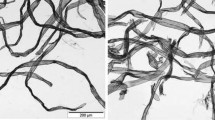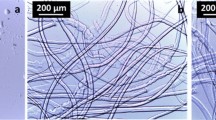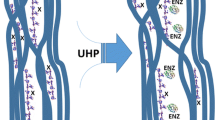Abstract
Dissolving pulps are used to manufacture various cellulose derived products through cellulose dissolution. Solubility of cellulose pulp has been claimed to be strongly dependent on the porosity development, the degree of polymerisation and the pulp viscosity. The removal of external cell walls has been proposed to have a key role in the pulp solubility. In this paper, the effect of the outermost surface layers on the solubility of a dissolving grade pulp was studied. Furthermore the effect of mechanical peeling and combined mechanical and enzymatic treatment on pulp solubility was compared. Based on the results combined mechanical and enzymatic treatment efficiently opens up the fibre structure and has a clear positive effect on the solubility of dissolving pulp. It seems that long fibre fraction is less accessible to solvent chemicals than the other pulp fractions. Mechanical peeling of outer fibre layers does not improve fibre dissolution to NaOH/ZnO. Thus, it seems that peeling alone is not a sufficient pre-treatment prior to dissolution. The results also revealed that the peeling treatment does not enhance the effects of enzymes as the studied mechanical treatment does.




Similar content being viewed by others
References
Bailey MJ, Biely P, Poutanen K (1992) Interlaboratory testing methods for assay of xylanase activity. J Biotechnol 23:257–270
Bernfeld P (1955) Amylases, a and b. In: Colowick SP, Kapland NO (eds) Methods in enzymology, vol 1. Academic Press, New York, pp 149–158
Buchert J, Carlsson G, Viikari L, Ström G (1996) Surface characterization of unbleached kraft pulps by enzymatic peeling and ESCA. Holzforschung 50:69–74
Gehmayr V, Sixta H (2011) Dissolving pulps from enzyme treated kraft pulps for viscose application. Lenzing Ber 89:152–160
Gromov VS, Purina LT, Treimanis A, Konstantinova LM, Kampuse A (1976) Distribution of hemicelluloses and lignin in fiber walls of birch sulphite pulp. Khimiya Drevesini 5:3–12
Grönqvist S, Hakala TK, Kamppuri T, Vehviläinen M, Hänninen T, Liitiä T, Maloney T, Suurnäkki A (2014) Fibre porosity development of dissolving pulp during mechanical and enzymatic processing. Cellulose 21(5):3667–3676
Grönqvist S, Kamppuri T, Maloney T, Vehviläinen M, Liitiä T, Suurnäkki A (2015) Enhanced pre-treatment of cellulose pulp prior to dissolution into NaOH/ZnO. Cellulose. doi:10.1007/s10570-015-0742-8
Isogai A, Atalla RH (1998) Dissolution of cellulose in aqueous NaOH solutions. Cellulose 5(4):309–319
IUPAC (International Union of Pure and Applied Chemistry) (1987) Measurement of cellulase activities. Pure Appl Chem 59:257–268
Kallmes O (1960) Distribution of the constituents across the wall of unbleached spruce sulphite fibers. TAPPI 43(2):143–153
Köpcke V (2010) Conversion of wood and non-wood paper-grade pulps into dissolving grade pulps. Doctoral thesis
Köpcke V, Ibarra D, Ek M (2008) Increasing accessibility and reactivity of paper grade pulp by enzymatic treatment for use as dissolving pulp. Nord Pulp Pap Res J 23(4):363–368
Krause T (1967) Anderung der morphologischen Struktur und chemischen Zusammensetzung von Zellstoff-Faser bei mechanischer Abschälung der äusseren Wandschichten. Das Papier 21(7):385–393
Le Moigne N, Navard P (2010) Dissolution mechanisms of wood cellulose fibres in NaOH–water. Cellulose 17:31–45
Le Moigne N, Jardeby K, Navard P (2010) Structural changes and alkaline solubility of wood cellulose fibers after enzymatic peeling treatment. Carbohydr Polym 79:325–332
Lowry OH, Rosenbrough NH, Farr AR, Randall RJ (1951) protein measurement with the Folin phenol reagent. J Biol Chem 193:265–275
Rahkamo L, Siika-aho M, Viikari L, Leppänen T, Buchert J (1998) Effects of cellulases and hemicellulase on the alkaline solubility of dissolving pulps. Holzforschung 52:630–634
Sixta H (2006) Pulp properties and applications. In: Sixta H (ed) Handbook of pulp. Wiley, Weinheim, pp 1009–1067
Sixta H, Iakovlev M, Testova L, Roselli A, Hummel M, Borrega M, van Heiningen A, Froschauer C, Schottenberger H (2013) Novel concepts of dissolving pulp production (review). Cellulose 20(4):1547–1561
Tenkanen M, Siika-Aho M (2000) An a-glucuronidase of Schizophyllum commune acting on polymeric xylan. J Biotechnol 78(2):149–161
Tenkanen M, Gellerstedt G, Vuorinen T, Teleman A, Perttula M, Li J, Buchert J (1999) Determination of hexenuronic acid in softwood kraft pulps by three different methods. J Pulp Pap Sci 25(9):306–311
Treimanis A (2006) Advanced traditional methods of analysis of fiber surface layers—a powerful tool in research of lignocellulosics. La Chimica e l’Industria 88(2):72–75
Vehviläinen M, Nousiainen P, Kamppuri T, Järventausta M (2009) A method for dissolving cellulose and a cellulosic product obtained from a solution comprising dissoved cellulose. In: WO 2009/135875 A1
Vehviläinen M, Kamppuri T, Nousiainen P, Kallioinen A, Siika-aho M, Elg Christoffersson K, Rom M, Jaroslaw J (2010) Effect of acid and enzymatic treatment of TCF dissolving pulp on the properties of wet spun cellulosic fibres. Cellul Chem Technol 44(4–6):147–151
Acknowledgments
This work was a part of FuBio Cellulose program of the Finnish Bioeconomy Cluster FIBIC. The funding of the Finnish Funding Agency for Technology and Innovation (TEKES) is acknowledged. The technical assistance of Upi Anttila, Juha Haakana, Teija Jokila, Maija Järventausta, Jari Leino, Leena Nolvi, and Mariitta Svanberg is gratefully acknowledged. In memoriam: The authors wish to honour our recently deceased co-author Professor Arnis Treimanis.
Author information
Authors and Affiliations
Corresponding author
Rights and permissions
About this article
Cite this article
Grönqvist, S., Treimanis, A., Kamppuri, T. et al. The effect of the outermost fibre layers on solubility of dissolving grade pulp. Cellulose 22, 3955–3965 (2015). https://doi.org/10.1007/s10570-015-0709-9
Received:
Accepted:
Published:
Issue Date:
DOI: https://doi.org/10.1007/s10570-015-0709-9




